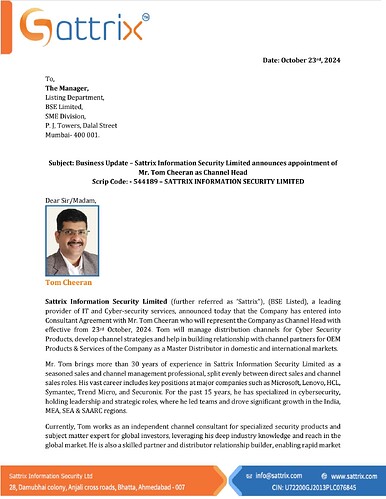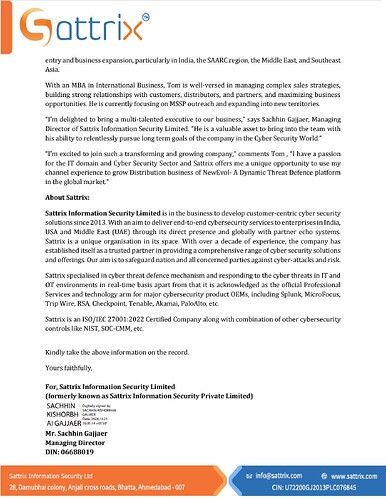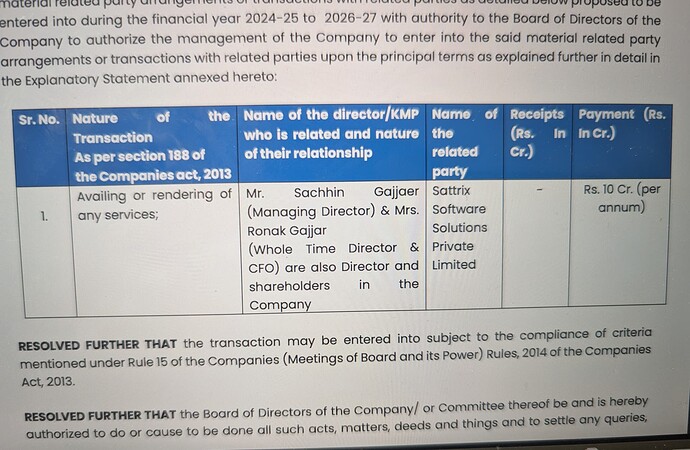About Sattrix Information Security Limited (SISL):
Founded in 2013, Sattrix Information Security Limited is a niche player in the cybersecurity domain, specializing in data protection service delivery, IPO was in June 2024
SISL has two subsidiaries Sattrix Information Security Inc and Sattrix Information Security DMCC in the US (Delaware) and UAE (Dubai) respectively. Both the regions Sattrix has customers and partners whom they work with to acquire customers.
They develop customer-oriented cyber security solutions. The company designs and builds data security solutions in the cloud and on-premise based on the client’s requirements.
Their cybersecurity solutions includes 4 verticals
-
Managed SOC (Security Operations Center) as a Service:
They work with clients directly for providing SOC as a service both on cloud and on premise, or with Partner OEMs (Original Equipment Manufacturers of Cybersecurity Products) or on a Hybrid Model for offering the entire spectrum of Cyber Security Services. -
Sattrix NewEvol Cybersecurity Platform Suite :
Offers its own Advanced Cybersecurity Threat Detection Platform called NewEvol with service capabilities like SIEM (Security Information and Event Management ) and SOAR (Security Orchestration Automation & Response), and offers similar features at a much cheaper cost than its much more expensive global security platforms like Q Radar (IBM), Splunk (Cisco) & Sentinel (Microsoft). This platform has been completely developed by Sattrix Software Solutions, a separate company owned by the founder. -
Professional IT Infrastructure Management
(Helpdesk Support/ IT Infrastructure Support): Helps organizations of all sizes and sectors implement and operationalize cybersecurity initiatives, technology transformation, and IT cost optimization by giving a comprehensive overview of a modern IT infrastructure to enable better and faster threat detection, response, and mitigation. . -
Vulnerability Assessments & Compliance:
Provides a suite of solutions to protect organisations from a Cybersecurity breach. They offer penetration testing, red teaming, anti-phishing solutions, and applications security services These solutions deliver a holistic evaluation of the IT infrastructure, including systems, networks, current applications, and operating procedures. They conduct thorough assessments, simulating real-world attack scenarios, reviewing source codes, and advising on best practices. The vulnerabilities and potential threats are identified and solution provided on how to mitigate them.
Expertise in
- Compliance as Service
- SOAR as a Service
- IR as a Service (Incident Response)
- SOC as a Service/ Hybrid SOC Management
- SIEM Consulting
- MSS for Stock Brokers Community (Managed Security Services)
Key Management Profile
Sachhin Gajjaer (Founder CEO) He has worked with Microsoft, HCL Systems, Accenture and has extensive experience in Information Security, Data-Centre Implementation, Solution Architecting, Risk & Compliance Management. He is the brains behind their cybersecurity platform NewEvol (https://www.newevol.io/). He has worked for over a decade in the UAE, KSA and Bahrain region including the GCC countries and Africa
Balaji Subramaniam (Global Strategy & Alliances) He is the Head of Global Strategy at Sattrix. He previously worked as the Head of Cybersecurity Business at NTT India and held leadership positions at GE and Cisco. He is an engineering graduate and holds a diploma in Strategic Leadership from Nanyang Business School Singapore.
Bhavik Patel (Regional Head of India) He is a skilled professional in organizational operations, network and system administration, firewalls, SIEM, customer service and sales, and information security. With a strong engineering background in hardware and networking, he has demonstrated his abilities in managing and leading teams and driving business growth.
Mohan Madwachar (Country Manager- Sales Transformation) is an experienced IT professional with over 30 years of experience including Wipro. His area of expertise lies in managing complex Network and Cybersecurity projects. He has designed, implemented, and managed several Critical National Infrastructure (CNI) projects.
HUGE OPPORTUNITY
Total Addressable Market (TAM) Cybersecurity market worldwide in 2024 is approx. 200 Billion USD and in India it is 4.7 Billion USD (Source : modorintelligence), and this market is growing at over 15-18% CAGR YoY.
TAILWINDS :
A) Growing Cybersecurity Attacks
An alarming wave of cyberattacks is sweeping across India, compromising millions of personal records, thus requiring stronger regulations and other countermeasures to plug the critical weaknesses in the nation’s digital infrastructure. India has over 1.15 billion phones and more than 700 million internet users, and 39 billion UPI (Unified Payments Interface) transactions, and this number is growing, any successful cyberattack on a critical asset such as a power grids, nuclear plant, railways, defence, satellites, banks will have a multiplier effect, crippling communications, transportation, defence and potentially endangering the health, security, finances and safety of citizens.
According to CrowdStrike survey, almost three-fourths of Indian corporates were hit by a ransomware attack in 2024
In the past few years, India has become a magnet for cyberattacks. According to a report by the American cybersecurity firm Zscaler, entities in India experienced 79 million phishing attacks in 2023.
In 2024 alone, major entities including Star Health Insurance, Crypto Exchange WazirX, BSNL, Boat India, Sparsh (Portal by TCS for Indian Defence Personnel), and the Supreme Court’s YouTube channel have fallen victim to cyberattacks, leading to significant data breaches and temporary shutdowns.
B) Govt (GOI) Introducing New Policies in Cybersecurity :
As India’s digital landscape continues to expand rapidly, the need for robust cybersecurity measures across various sectors has become increasingly important. Different industries, including finance, healthcare, telecommunications, and critical infrastructure, have specific cybersecurity requirements governed by sector-specific regulations.
Some recent key cybersecurity regulations in India that have been put in practice in 2023-24.
IRDAI: Guidelines on Information and Cyber Security (2023) : All Insurers including FRBs, Insurance Intermediaries covering Brokers, Corporate Agents, Web Aggregators, TPAs, IMFs, Insurance Repositories, ISNP, Corporate Surveyors, MISPs, CSCs and Insurance Information Bureau of India (IIB) shall adhere to the said Guidelines.
Digital Information Security in Healthcare Act (DISHA): Though still in the draft stage, DISHA aims to provide a comprehensive framework for data protection in the healthcare sector. It proposes stringent guidelines for the collection, storage, and sharing of health data and prescribes penalties for data breaches.
Ayushman Bharat Digital Mission (ABDM) Guidelines: The ABDM provides a regulatory framework for digital health data management, interoperability, and security. It emphasizes the use of secure, standardized protocols for data exchange and mandates that all health data be stored securely.
Telecommunications (Telecom Cyber Security) Rules, (2024) . These rules aim to bolster the cybersecurity of telecommunication networks and services, establishing comprehensive guidelines for data collection, security measures, and incident reporting.
Digital Personal Data Protection Act, (2023) The primary purpose of the Act is to regulate the processing of digital personal data and respect individuals’ right to protect their data while recognizing the necessity of processing and using such data for lawful purposes.
SEBI has issued a Cybersecurity and Cyber Resilience Framework (CSCRF (2024) ) for various entities regulated by SEBI for countering Cyber Attacks and Cyber Terrorism. Under this framework registered entities will be graded into five categories based on various parameters: Market Infrastructure Institutions (MIIs); Qualified REs; Mid-size REs; Small-size REs and self-certification REs.
National Cyber Security Reference Framework (NCRF) 2023 has been approved, provides guidelines for organizations and regulators to help build strong cybersecurity systems. It was shared with companies and government departments for consultation in May 2023 but is not yet public.
C) Trend of Shift from Cloud to On-Premise Security :
There’s a change in the winds of IT infrastructure. After a decades long rush to the cloud, many organizations are now exploring ways to exercise more control over their data and IT infrastructure.
Rather than depending solely on third-party cloud services, they’re looking to operate their IT data networks on-site. This strategy, often referred to as on-premises or on-prem, is gaining renewed interest thanks to factors such as data privacy and security concerns, regulations designed to hold organizations accountable for the data they collect, and the rise of artificial intelligence. This is good for SOC companies that can work on a Hybrid model for their clients
Key Customers : Over 200 + active clients in India/ Middle East & USA
Some of their prominent customers include:
WNS, SBI Card, Concentrix, Ramco Systems, National Payment Corporation of India (NCPI), Niva Bupa Health Insurance Company Limited, Fullerton India, NTT India, RSA Security & Risk Ireland Limited
No of Employee : Approx 300, Doubled the number of employees in less than 1 year
The number of employees during the time of Filing for IPO in Oct 2023 as per DRHP was 145
The number of employees in as per the annual report FY 2024 was 284
So, they have doubled their employee strength in less than a year
Investment Thesis
- Multiple Optionality: This gives their business big advantages to offer multiple services and products
- They offer their Own Cybersecurity Product (NewEvol)
- They have their own SOC as a Service Capability
- They act as SOC delivery partners for Implementation Partners like Valuepoint, Ingram, Trend Micro etc, these implementation partners outsource the SOC services to them
- They offer IT Infrastructure Services/ Transformation
- Threat assessment and compliance service
-
Operational Leverage: With a full-fledged low cost SOC service center fully functional and fully paid for, every additional business will directly flow to their bottom-line profits
-
High Switching Cost: There is a high stickiness/switching cost because they develop “Parsers” that act like bridges to integrate client’s old legacy systems to the new age cyber security products. This tech code is built by the Sattrix team using its own team of Software Developers.
-
High Entry Barrier: The set-up cost of a SOC is fairly high, Skilled manpower is expensive and not easily available, sticky clients with 3-5 years contract period makes it difficult to crack them.
-
Big IT Players no longer interested in the Managed SOC as a Service Market: The big players like Wipro, TCS, Infosys are no longer looking at the Indian market due to margin issues and have started focussing in markets with better margins. This gives players like Sattrix a huge playing field and a chance of capturing a big potential market that is ignored right now.
-
Fragmented Competition: The number of SOC players though seem high but are small in size and often lack the capability to handle projects of different sizes and complexities. The bigger players like the big 4 consulting players (E&Y, Deloitte, PwC, KPMG) and telecom players have their own limitations in taking up SOC projects where margins are low.
-
Big Customer base: Almost 200 active clients in India, Middle Ease, South East Asia and USA for a small player in itself reflects their competence and ability to deliver.
-
Secular Business: The average contract with clients is 3-5 years which gives them business visibility and stability.
-
Only listed player offering Managed SOC as a service and has its own Cybersecurity Platform. This adds to their credibility and makes it easier for them to get business
-
No Debt: There is no debt on the balance sheet and it’s a Cash flow positive business
-
In house Training Capability: Sattrix has a strong in-house cyber security training capability, this allows them to take college freshers from the local colleges near Ahmedabad at low salaries and train these students to be come full fledged cyber security professionals in 6 months and then graduate to higher positions within the company. These helps them attract and retain talent in an industry where its difficult to find skilled talent
-
Highly Skilled Team: Sattrix has a team of 40-50 Software Developers which work on their own cyber security product/ platform and SOC capabilities, this gives them huge advantages when compared other SOC players.
-
Micro Cap : Market capitalisation of only 120 cr. Has a huge runway ahead
-
Increased Focus from Indian Govt: The government has prioritised cyber security, and is actively floating tenders, this can be seen in the governments GeM portal (Government e marketplace). Sattrix has participated in multiple tenders.
-
High Promoter Ownership: The Promoters own 73.5% stake in the business.
-
Presence in other Regions: They have 2 subsidiaries, one in Middle east(Sattrix Information Security DMCC) and one in USA (Sattrix Information Security Inc). This gives them an additional advantage to handle clients in different locations and also to use those locations to do the backend SOC job in India.
Key Risks
-
Key Person Risk: Although the top management profile looks good but still there is a lot riding on the founder as the company is young (around 11 years old) and seeks the founders experience and expertise to keep growing
-
OPM & PAT Margin: The OPM & PAT margin in FY 2023 and FY 2022 was around 12% and 10% respectively, while in FY 24 it fell to 6% and 5% respectively. It needs to be ascertained why the margins/Profits came down and what could be the margins going forward.
-
Threat of Big players re-entering the market: The big players like WIPRO, TCS etc are no longer focusing on SOC as as a Service in the Indian market (Big opportunity for Smaller Player like Sattrix) due to comparatively lower margins, they may re-enter, but it seems unlikely considering their higher overhead costs.
-
Risk of AI: There is a risk of AI disrupting the IT Industry, and for Cybersecurity, some of the jobs that can be impacted would be the entry level (L1) jobs. However, right now considering the importance of cybersecurity, organizations would not want to trust their data to an AI bot till the tech gets very reliable and has a proven history behind it, this is still at least a few years away, and even then, the Cybersecurity Industry would be positively impacted due to sophisticated hackers using AI to their advantage, and hence the increased importance of skilled cybersecurity workforce.
-
Expensive Valuation: The earlier PE was around 30 (during IPO) and the current PE is 70, and seems expensive, this happened because in FY24 profits came down, but now with over 100% increase in hiring, a bigger SOC capability in the new office premises, and more business added (due to hiring) the numbers are bound to look better in FY 25 and the valuation will come down.
In Conclusion : A microcap company with big entry barriers, operational leverage kicking in, switching cost moat, huge industry tailwinds, over 200 big clients and govt push give it a strong edge. In addition, they have a strong leadership in place with a impressive execution track record, also, they seem to be on a hiring spree to consolidate their position in the Managed SOC as a Service and Cybersecurity Market. All this while having zero debt on the books makes it a stock to study .
Disclaimer : Invested




